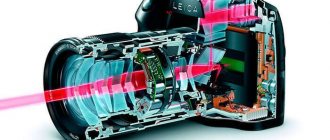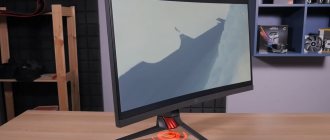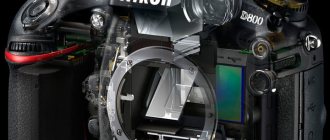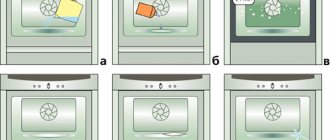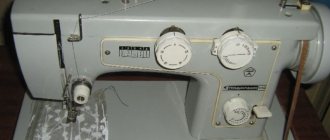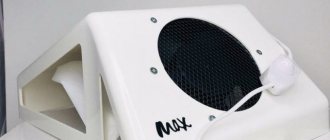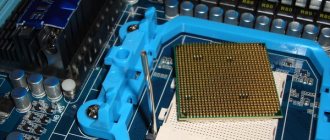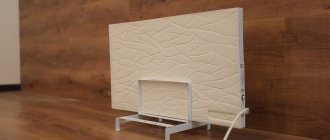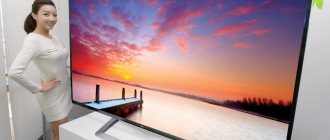The matrix of a liquid crystal display needs to be backlit unless the LCDs are created using organic molecules - OLEDs, which themselves emit photons of light. Depending on its type and quality of implementation, the purity and realism of the picture, the presence of highlights and shadowed areas on the TV or monitor screen depend. Let's look at what types of backlights are currently used in TVs with LED displays.
Features of backlighting in modern LCD screens
Initially, fluorescent lamps were used to backlight LCD screens of monitors and televisions. Yes, you read that right: these were the same “fluorescent lamps” previously widely used to illuminate industrial and public buildings. Only in this case their size was much smaller. In the electronics world, this development was called CCFL.
The presence of mercury in the flasks led to the risk of poisoning the user if the display was damaged
But let's be honest, such technology became obsolete a couple of decades ago. It has long been replaced by high-performance LEDs. They received the famous name LED (short for Light-Emitting Diode). In addition to environmental safety for humans and the environment, they are also distinguished by low energy consumption and relatively inexpensive manufacturing costs.
LED lamps can take on any shape or size. This advantage allows manufacturers to create convenient and unusual models of equipment.
The use of such an invention could not but give rise to the subsequent creation of several subtypes of lighting. Perhaps even now some innovative developments are underway, but in 2021 the user’s choice is conditionally divided between two common solutions:
- Direct LED.
It is about the features of these competing “sisters” that we will tell our readers as part of further research.
Want to know what type of equipment is best for high-quality pictures? Continue to read our article carefully, and the answer will not be long in coming.
What is better to choose
Direct led or edge led – which is better to choose depends on various parameters, which include the individual wishes of the buyer and the conditions of placement and operation. Here are some tips for choosing a TV:
- It is better to install a thin case with edge LED on flat walls;
- if the screen will be placed in a suspended or inclined state, it is better to buy direct ice to avoid deformation of the light diffuser;
- edge ice have higher brightness than carpet type devices.
Important! When purchasing an edge led TV, the image quality must be checked directly in the store. The exposed parts will be visible on the blue screen.
Edge LED lighting technology – compact and stylish solution
The first option in our case will be an unusual and, to a certain extent, experimental Edge LED backlight. Despite the fact that it has a number of significant disadvantages, its use in modern screens is often justified.
Edge LED Design Features
To fully understand what Edge LED backlighting is, we first need to translate the first word from the name into Russian. For those who do not want to look in the English-Russian dictionary, let us tell you that the term “Edge” means “Angle”. This leads to the main distinctive feature of the technology: this backlight is located on the side edges (most often, the right and left edges) of the inner surface of the display.
The angular arrangement of lamps has found wide application in everyday life, for example, in mirrors or shop windows.
Ultimately, this leads to a reduction in the thickness of the monitor or TV, as well as less strain on the eyes. But there is also a very large “fly in the ointment” - if the number of lamps on the sides of the screen and the power of their glow are incorrectly distributed, local darkening or, conversely, too bright fragments will be noticeable in the picture.
The thinner your TV or monitor, the more likely it is to have Edge LED installed.
Advantages and disadvantages
Like any scientific invention, the heroines of our review have strengths and weaknesses. We partially described the benefits and disadvantages of Edge LED in the previous paragraph, but now let's put all the pros and cons together for a more complete picture.
| "Pros" | "Minuses" |
| More compact dimensions of the matrix and body of the LCD device due to the favorable arrangement of the elements. | Increased energy consumption due to the need to illuminate a large area with a small number of LED lamps. |
| High brightness levels and ease of viewing information. | High risk of local darkening due to incorrect calculations by manufacturers. |
Uneven light distribution not only spoils the appearance, but also interferes with the enjoyment of movies or video games
Composite LEDs
The screen backlight is created by standard LED components with appropriate current, voltage and power values. The last parameter determines the luminous flux, which is formed by a certain model of LED elements, and the efficiency of the system.
Direct lighting differs from classic RGB. Tri-color LEDs were supposed to improve the color gamut, but this did not work out as there might not be enough color. Therefore, engineers developed other light-emitting diodes to achieve the desired result. The technology currently uses quantum dots or GB-R and RB-G LED diodes. They differ in that in the first case, the blue and green LEDs are combined into one and covered with a red phosphor, and in the second case, red and blue are combined and covered with a green phosphor.
Edge LED backlighting uses small white light-emitting diodes. Each component is responsible for illuminating a specific part of the screen.
Direct LED backlight technology – always shine, shine everywhere
The only and very successful competitor of the first nominee is Direct LED - a more expensive and spectacular option with a lot of interesting parameters. Let us immediately begin to study its characteristics.
Design features of Direct LED
Answering the question “What is Direct LED?” , we again turn to the English-Russian dictionary, where it is said that “Direct” means “Direct”. This is the creators' idea. Unlike Edge, in equipment using a similar technology, LED lamps are located not on the side edges, but on the back wall, over the entire area, but at a certain interval.
This method requires large investments both at the production stage and during purchase - but the result is worth it
As a result, you will get a contrasting picture, the characteristics of which can be easily changed without harming the image quality. You also don’t have to worry about various local dimming of the matrix - they will appear only in the event of large-scale breakdowns, which happens extremely rarely.
The owner of a Direct LED screen can independently adjust the brightness, increasing and decreasing the power of the LEDs.
Advantages and disadvantages
As in the first case, this heroine of our review has a number of strengths and shortcomings. Let's try to bring them together to form a full-fledged opinion.
| "Pros" | "Minuses" |
| High contrast and image sharpness. | The dimensions of the device will be significantly thicker compared to Edge models. |
| The absence of any illumination deficiencies in one or another area of the display due to the rational arrangement of elements. | Even higher power consumption due to the large volume of diodes. |
<
Be prepared for the fact that your electricity bill when using a Direct TV or monitor will be much higher than under other conditions
Advantages and disadvantages of LED TVs
Let’s immediately understand what LED backlighting on a TV is. The matrix of such a display consists of a special substance - liquid crystals. Their molecules have the properties of a liquid (fluidity), but have an ordered structure - a crystal lattice.
LCs are located between electrodes, changing the voltage across which controls the position of the crystal molecules. Depending on it, LCDs transmit light with a certain wavelength (color) or not. Moreover, these electromagnetic waves first pass through polarizing filters: one transmits only rays oriented in the horizontal plane, the second - in the vertical plane. And so on for every pixel on the screen.
LED backlight is a light source that makes images appear on the display.
Depending on the method of its installation, two technologies are mainly used in the production of TV receivers: Direct LED and Edge LED. Let's look at which backlight is better on TVs and in what cases.
From the point of view of consumers, devices with LED backlighting differ from those where the light source was lamps in the following criteria:
- the darkest and lightest shades are conveyed much better - high contrast;
- improved color rendering;
- less electrical energy consumption;
- the dimensions and weight of televisions have been reduced - some models are about 1 inch thick;
- eyes get tired faster due to exposure to short-wave radiation of blue-violet tones;
- the predominance of cold (bluish) shades - “bluishness” of the picture;
- reduced pixel persistence time made it possible to get rid of image blur;
- environmental friendliness - no mercury is used in the production of the matrix.
Which is better – Direct LED or Edge LED
We have looked at the characteristic features of each of the currently available options. “But this is only theoretical information,” the reader will say, and he will be right. Don’t forget the practical application of existing knowledge. It is for this reason that the next point of our review will be to identify the worthy winner in the “Edge LED vs Direct LED” duel!
Two irreconcilable “rivals” often clash for the attention of buyers. Let's see who will ultimately get the laurels of the winner
The best solution in terms of image quality
Each of us wants to enjoy bright, rich colors while watching a dynamic blockbuster, an intense game in the next computer or console video game. But what type of backlight is best to choose to achieve the perfect result? Let's consider each of them separately.
Edge LED. On the side of this nominee is increased brightness, combined with rational light direction, reducing eye strain. But at the same time, the image may be more “blurred” due to lower contrast. Therefore, this offer is suitable for those who work a lot behind a screen or are afraid for their eyesight.
Blurred image features will prevent you from fully enjoying a Full HD movie or a modern action game
Direct LED. In this case, we have higher sharpness and contrast, which, coupled with adjusting brightness and saturation, can give a much more powerful and consistent result. Such devices are the best choice for demanding viewers and avid gamers.
Remember that a very contrasting and richly colored picture puts additional strain on the eyes, worsening your vision
The optimal parameter in terms of reliability and design
In addition to the quality of the image itself, do not forget about the durability and pleasant appearance of the equipment. After all, what is the use of equipment if it breaks after a month of active use? Let's look at the heroines of our review from this side of the issue.
Edge LED. As we said earlier, models equipped with such lighting have much more compact dimensions, which has a positive effect on the design. But a small thickness is also an indicator of high fragility, which should also not be discounted. At the same time, this technology does not work well on inclined surfaces, since over time the light diffuser can suffer serious physical deformations.
Pets can easily damage expensive equipment without a second thought. If you have pets at home, then Edge LED is clearly not your choice
Direct LED backlight, unlike its rival, on the contrary, thickens the dimensions of the screen. In some situations, this can also be a negative, since massive objects are destroyed much more when they fall. But with proper fastening and control, this solution is more profitable in all respects. In addition, this technology is suitable for placement on any surface, which is convenient for every user.
Direct models perform excellently at any angle of inclination without losing their characteristics
Types of ice backlight
Edge lighting, also known as edge led or side lighting - in it, the emitters are located along the edges of the matrix, usually on the left and right sides. The emitted light hits the diffuser and is then scattered. The use of edge technology makes it possible to make a thin TV body, but there will be increased demands on the accuracy of the placement of diodes. If the arrangement is violated, glare will appear on the screen.
Carpet lighting (Full HD LED, LED Pro, Direct LED) – diodes are installed directly behind the matrix. With this technology, illumination uniformity increases and segmented control of LED blocks can be used.
Main conclusions
Modern TVs use LED backlighting. It is highly efficient, allows you to reduce the width of the body, is environmentally friendly and looks stylish. There are two types of LED backlighting – direct or edge. Differences in types lie in different arrangement of blocks, number and type of LEDs. In direct ice technology, LEDs are placed throughout the matrix, and in edge - on the sides. Which direct led or edge led backlight is better is determined by the user's requirements and conditions of use.
Previous
Lamps and luminairesChoosing the best LEDs for a flashlight
Next
Lamps and fixturesProcedure and diagram for replacing fluorescent lamps with LED lamps

